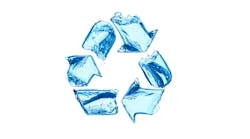Q: I have a customer with a well supply that is high in sodium ranging from 2,500 to 3,500 ppm on three tests I have done.
The only tests I have are as follows: 8 gpg hardness, < 0.3 iron, 7.5 pH and 0.2 ppm H2S.
They currently have an air injection system to remove the trace iron and the odor, which is working great, but they would like to reduce the sodium spotting. I would like to know if softening the water with KCl (potassium chloride) would help reduce the TDS enough to make a difference, and is there an archive article that I could read about this topic?
A: TDS cannot be reduced by regenerating a water softener with KCl instead of NaCl. This will only convert the Na added by softening (not all the Na) into K — no change to the total TDS. Also, the high sodium concentration in this water sample would make it extremely hard to soften without a high amount of continuous hardness leakage. The way to reduce the leakage normally is to increase the KCl or NaCl dosage, which would not be advised given the high raw-water sodium. When raw water sodium is this high it tends to act like a low level regenerant, even when softening. My advice is to forget about softening regardless of which regenerant is used.
Deionization and reverse osmosis are two common ways of reducing TDS. I recommend following your existing system with a whole-house RO system. Don’t just buy one from a catalog. Be sure to find a good vendor with expert technical support. Before making contact establish the treated GPD needed. Be prepared to discuss this, the high TDS and treated water storage volume. I normally recommend taking the water needed in one day, then subtracting the amount a given RO will produce in one day. The remainder is the volume of storage needed.
Also consider reusing the reject water. Flushing toilets is always one good start for recycling this water.
You will probably need a higher-than-standard pressure RO pump.
Many of these topics can be found in our archives at www.watertechonline.com.
Q: I work for a small bottled water manufacturing facility. It’s a new operation and we are looking into building a new facility with a new filling line. My question is whether we need to install a bottle washing line/station or can we have clean air blown into bottles to remove any contaminants? Also, do we need to clean/wash our caps too? We have an induction seal on the caps so not sure if washing them would be ideal?
A: In the U.S., water bottling is regulated. I suggest you contact the International Bottled Water Association (IWBA). They might be able to furnish you with a copy of these regulations.
I can tell you that you will need more than clean air to be safe. Usually disinfection at the point of bottle filling is required. A few of the methods used are UV, ozone, chlorine dioxide and membrane filtration. Sometimes a combination of the above methods is used.
Q: What type of potassium may I use in a standard washing machine?
What is 20 meq of potassium chloride when converted to mg?
A: I don’t know why you want to know these things, but I would be very interested.
I’m not aware of potassium being used in (I assume you mean) clothes washing machines. On the other hand I could understand potassium (K) and phosphorous (P) getting mixed up.
Phosphorous is used in clothes washing detergents and is predominantly pentasodium triphosphate (PSTP). It has the ability to disperse dirt in the washing solution.
In 16 to 18 of the U.S. states there is a “ban” on high levels of detergent phosphates over 0.5 percent due to their action in the waste streams of causing an overgrowth of vegetation, depletion of oxygen, fish-kill and a slow sedimentation with eventual plugging of the stream.
The 20 meq of KCl converts to 1492 mg.
Q: Dear David,
I had asked you a question several months ago, but unfortunately did not get any answer.
Do you really answer the questions or do you publish your answers on some blog or website?
If you do, please let me know where, so I could see it, if you do not, I will repeat my questions and hope that this time you will give me an answer.
I am interested to know if there is any reason to use or manufacture dry air fed ozone generators? Does it make any financial sense or is there also technical merit to it?
I am genuinely interested in your opinion.
— Canada
A: The moisture level in the air fed to ozone generators is directly related to the ozone output. More moisture equals lower ozone output.
Because the presence of moisture affects ozone production and leads to the formation of nitric acid, the air feeding an ozone generator must be very dry. Nitric acid is very corrosive to some internal parts of an ozone generator, can cause premature failure and will increase the frequency of required maintenance. You should have reliable air drying equipment.
Although ozone can still be generated with moist air, the ozone output is greatly reduced and therefore not only is equipment damage a possibility, but there is a cost savings when the feed-air is dry.
I checked my files and unfortunately did not find your first question. I apologize. I only publish answers to reader’s questions in Water Technology magazine at which time they also appear on our website www.watertechonline.com.
Some questions are not fitting to our field of work and some are not clear enough or are lacking in detail. I also attempt to answer some of these privately, or if they can fill in missing information, then I will use them in print.
Q: H2SO4 (sulfuric acid) is used to condition the pH of our water. Will SS 316 MOC be suitable to handle commercial grade H2SO4 or not?
— India
A: I recommend that you contact the National Association of Corrosion Engineers (NACE) in the U.S. for this type of information.


